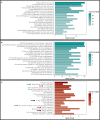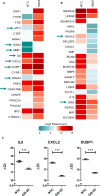Systems Immunology Analysis Reveals an Immunomodulatory Effect of Snail-p53 Binding on Neutrophil- and T Cell-Mediated Immunity in KRAS Mutant Non-Small Cell Lung Cancer
- PMID: 33381110
- PMCID: PMC7768232
- DOI: 10.3389/fimmu.2020.569671
Systems Immunology Analysis Reveals an Immunomodulatory Effect of Snail-p53 Binding on Neutrophil- and T Cell-Mediated Immunity in KRAS Mutant Non-Small Cell Lung Cancer
Abstract
Immunomodulation and chronic inflammation are important mechanisms utilized by cancer cells to evade the immune defense and promote tumor progression. Therefore, various efforts were focused on the development of approaches to reprogram the immune response to increase the immune detection of cancer cells and enhance patient response to various types of therapy. A number of regulatory proteins were investigated and proposed as potential targets for immunomodulatory therapeutic approaches including p53 and Snail. In this study, we investigated the immunomodulatory effect of disrupting Snail-p53 binding induced by the oncogenic KRAS to suppress p53 signaling. We analyzed the transcriptomic profile mediated by Snail-p53 binding inhibitor GN25 in non-small cell lung cancer cells (A549) using Next generation whole RNA-sequencing. Notably, we observed a significant enrichment in transcripts involved in immune response pathways especially those contributing to neutrophil (IL8) and T-cell mediated immunity (BCL6, and CD81). Moreover, transcripts associated with NF-κB signaling were also enriched which may play an important role in the immunomodulatory effect of Snail-p53 binding. Further analysis revealed that the immune expression signature of GN25 overlaps with the signature of other therapeutic compounds known to exhibit immunomodulatory effects validating the immunomodulatory potential of targeting Snail-p53 binding. The effects of GN25 on the immune response pathways suggest that targeting Snail-p53 binding might be a potentially effective therapeutic strategy.
Keywords: T-cell mediated anticancer immunity; immunomodulation; neutrophil-mediated anticancer immunity; non-small cell lung cancer; snail-p53 binding; systems immunology; tumor sensitization.
Copyright © 2020 Hammoudeh, Venkatachalam, Ansari, Bendardaf, Hamid, Rahmani and Hamoudi.
Conflict of interest statement
The authors declare that the research was conducted in the absence of any commercial or financial relationships that could be construed as a potential conflict of interest.
Figures





References
Publication types
MeSH terms
Substances
LinkOut - more resources
Full Text Sources
Research Materials
Miscellaneous

